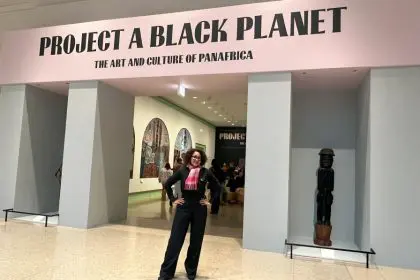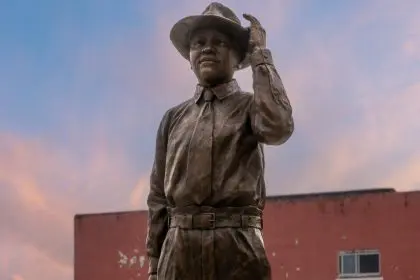
Sculptors Martin Puryear and Theaster Gates, generations apart in their respective crafts, came together before a sold-out audience at the Art Institute of Chicago to discuss their journey through the art world. Their conversational styles reflected their work — Puryear, a noted solitary artist was serious and straight to the point; while Gates, a social sculptor, was loose and humorous. Puryear, whose exhibition is currently showing at the Art Institute of Chicago, joked that as the older artist, he was pulling rank over Gates and initiating the conversation.
Puryear’s opening dialogue reflected on an art world of the ’70s that hasn’t always been appreciative of the talent of African American artists. He recalled a story of a friend whose art consisted logging the absence of Black artists in popular publications like the New York Times. With Puryear and many other Black artists now being celebrated on an international level, he no longer felt marginalized in the art world and with a sense of long overdue pride stated, “Blacks are no longer invisible.”
Puryear’s attention to race and cultural concepts is evident in his work, some of which he attributed to his time spent as a professor and artist in Sierra Leone, where he taught French, English, biology, and art early in his career. The impact of Africa, rich with cultural tradition and symbolism, would be a point of connection for Puryear and Gates.

Gates also spent time studying art in South Africa, where the convoluted concepts of race, culture and social class seemed to shape not only his work, but his sense of social responsibility to his community. While recognizing Puryear’s transition from 2D to 3D works as a “maker,” Gates wanted to transition his work to a fourth dimension — the community. Gates’ art shifts between sculpting mediums such as clay, to the rehabilitation and beautification of distressed banks and homes. Puryear, a slow-working solitary artist expressed admiration for Gates’ work but couldn’t see how he had time to both create and attend city planning meetings. To that end, Gates expressed something that we all know to be true — that art is everywhere. It wasn’t until he was broke and unable to afford clay that he was celebrated for creating art with unconventional materials. While Gates stopped short of saying everyone is an artist in the traditional sense, he did challenge the notion that art had to subscribe to some predetermined artistic canon.
With so much to exchange an hour was barely enough time for Puryear and Gates to even graze the surface of their careers. There’s an old adage that says, “You don’t choose your work, your work chooses you.” It’s clear when listening to these artists that they work from the inside out. Very little of what they discussed dealt directly with the creation of art, but more about their personal identity and how they viewed themselves on the world canvas. After expressing a mutual admiration for each other’s work, and confirming that they could in fact call each other friends, Puryear and Gates bid the audience farewell.
Martin Puryear: Multiple Dimensions is on view at the Art Institute of Chicago until May 3.
Photos from the exhibition can be found in the gallery.














